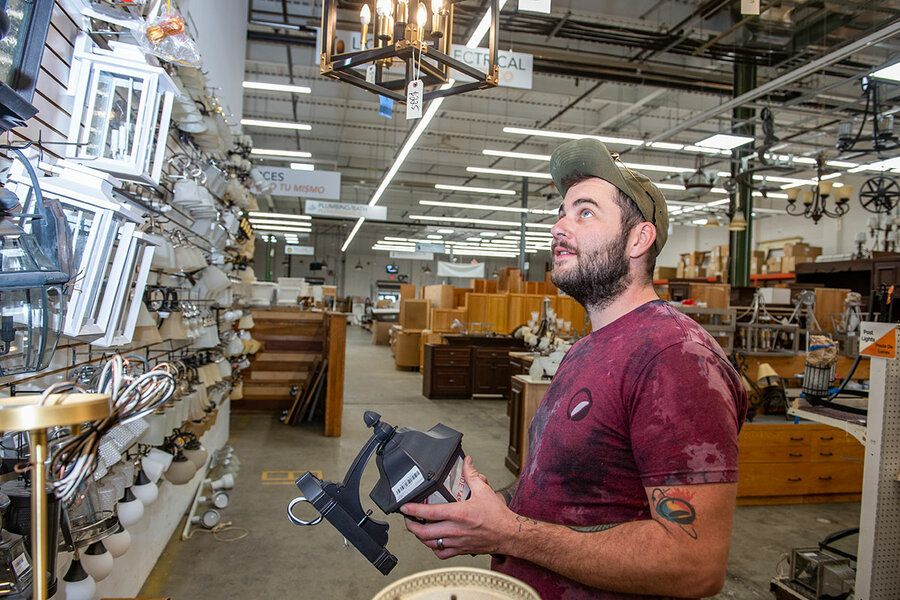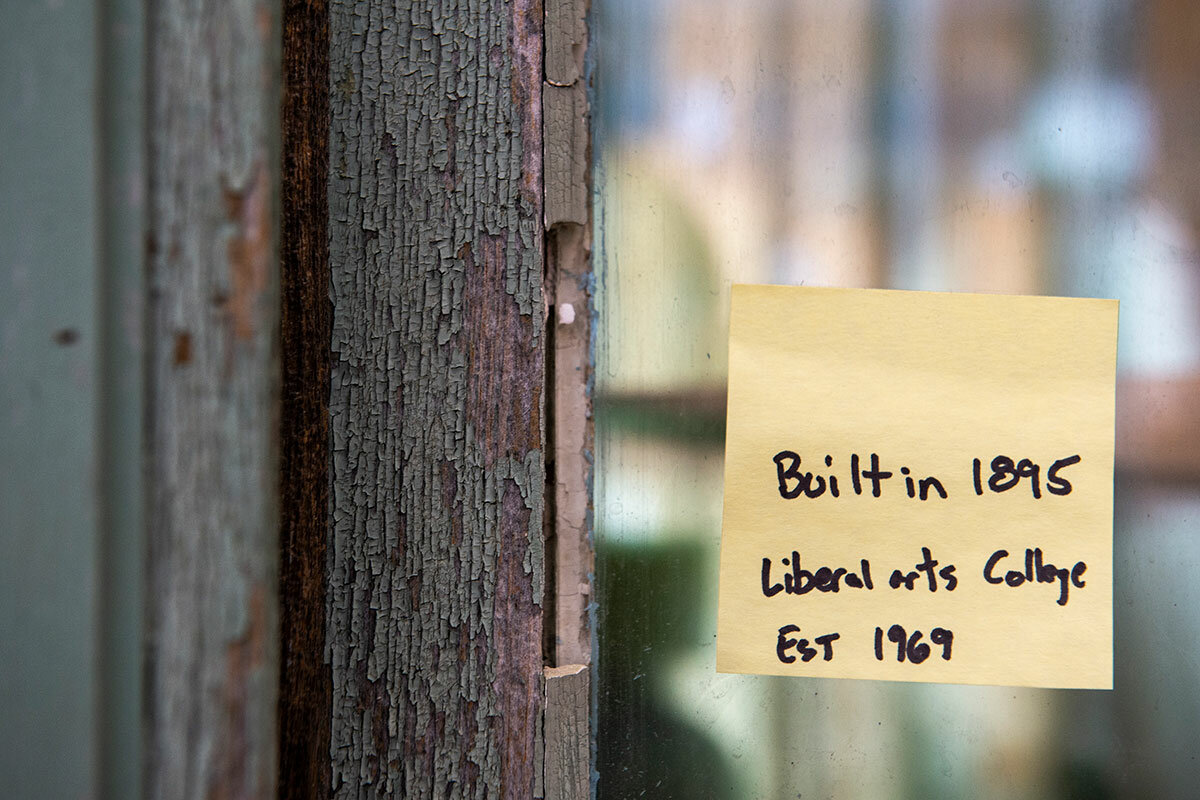This nonprofit helps old building materials find new homes
Loading...
| Springfield, Mass.
When Diane Sabato was planning her retirement home, one thing was certain: She wanted to have the smallest environmental impact possible.
To help achieve this goal, she turned to EcoBuilding Bargains, a retail warehouse for reclaimed building materials, for items such as secondhand cabinets for her kitchen.
Why We Wrote This
A story focused onTraditionally, construction waste is a major contributor to landfills. A nonprofit in Massachusetts is part of a growing movement to change that, with benefits for consumers as well as the environment.
Ms. Sabato’s desire to reduce the environmental footprint of her home is part of a growing trend. Reusing building materials keeps them in circulation for longer – preventing new items from being made, reducing carbon use, and eliminating landfill waste. It fits into what’s called the “circular economy,” efforts to keep resources in use for as long as possible.
EcoBuilding Bargains in Springfield, Massachusetts, stays stocked with consistent donations from contractors, whose multiple clients guarantee in-store supply. Materials arrive several days a week through a free pickup service.
While it may not be as easy as armchair shopping, the difference is tactile, says Naomi Darling, a sustainable design expert at Mount Holyoke College and University of Massachusetts Amherst who has worked with materials from the warehouse. “In some ways you can think of it like treasure hunting, because right around the corner you might find something really unique that’s hard to find.”
When Diane Sabato was planning her retirement home, one thing was certain: She wanted to have the smallest environmental impact possible.
To help achieve this goal, she turned to EcoBuilding Bargains, a retail warehouse for reclaimed building materials in Springfield, Massachusetts. Its carefully planned aisles and sections feature fiberglass windows, eco-friendly paints, and light fixtures, among other things. The difference here? The items are all secondhand.
A white cabinet set with glass inlay doors caught Ms. Sabato’s eye immediately. “They had just set it up,” she says. “I went, ‘This is it.’”
Why We Wrote This
A story focused onTraditionally, construction waste is a major contributor to landfills. A nonprofit in Massachusetts is part of a growing movement to change that, with benefits for consumers as well as the environment.
And Ms. Sabato had done the research to know a good find when she saw one. She spent under $8,000 for her completed kitchen, though she estimates the custom white cabinet set would have originally cost around $60,000 to $70,000. “I parked myself at the kitchen [display] and basically made faces at anyone that tried to come near it so they couldn’t buy it,” she adds.
Ms. Sabato’s desire to reduce the environmental footprint of her home is part of a growing trend. Reusing building materials keeps them in circulation for longer – preventing new items from being made, reducing carbon use, and eliminating landfill waste. Reuse also creates multiple price points for higher quality goods, increasing accessibility. This cycle cuts costs for both consumers and the climate while innovating traditional use and discard practices.
“As we add millions and millions of square feet to our planet every year we really have to think about the finite resources, material resources that we have and how to enable all the resources that are already out there to have a longer life,” says Naomi Darling, five college associate professor of sustainable design at Mount Holyoke College and University of Massachusetts Amherst who has worked with materials from EcoBuilding Bargains.
The reuse of building materials fits into what’s called the “circular economy” – the use of regenerative processes in industry and the economy to keep resources at their highest value for as long as possible.
“In a linear system, we extract resources from the earth, we make them into food and products, and then we dispose of them, usually right into a landfill,” says Sandra Goldmark, professor at Barnard College and senior assistant dean at the Columbia Climate School. That’s in contrast to a circular system where products are kept in use through repair, recycling, or remanufacture.
The growth in reuse is coming from the ground up. Frustrated with waste, people are looking for alternatives to the broken system of production and consumption. Although reuse isn’t a new phenomenon, Ms. Goldmark says it’s exciting to see companies, cities, and communities use technology or policy to make the familiar practice of circularity easier again.
The Center for EcoTechnology, the umbrella nonprofit encompassing EcoBuilding Bargains, opened its 30,000-square-foot selling space in 2011, after its founding in 2001. The largest warehouse of its kind in New England, it offers creative solutions for building-material waste that are in turn fostering a small-scale reuse economy across the region. It has shipped items to all 50 states and 12 countries, including easy-to-transport tile and unique antique finds.
In addition to the Springfield warehouse, other groups are working to make circularity more prevalent in the built environment.
To cite one example, Urban Wood Economy, headquartered in Baltimore, operates a model of wholesale wood distribution that aims to capture value from the urban wood waste stream. It is involved in projects in Pittsburgh; Philadelphia; Memphis, Tennessee; and San Diego, with the goal of scaling up.
Cornell University’s Circular Construction Lab is ushering in the next generation of regenerative architecture through its design research program. Felix Heisel, director of the lab and an assistant professor in the Department of Architecture, sees recent increased interest in built environment circularity. “We all woke up and saw how much damage the built environment does,” he says.
Depending on the job, Chris Shea, manager of Domus Constructors LLC based in Fairfield, Connecticut, saves anywhere from $100 to a few thousand dollars on disposal costs. Clients also receive a tax credit from the items they donate. It’s a goodwill his customers appreciate.
Customers can expect to spend a quarter to a third of new market value when purchasing from EcoBuilding Bargains. “They could maybe buy a window for $200 or $100 instead of buying one for a thousand,” Mr. Shea says.
The items he donates are perfectly good for reuse, he adds. “Some people think, ‘Oh, this is the stuff that the people don’t want,’ but ... most people would be really happy to have it.”
How does EcoBuilding Bargains stay stocked? Items arrive several days a week through its free pickup service, which employs full-time delivery drivers. Its stable inventory is also largely thanks to consistent donations from contractors, whose multiple clients guarantee in-store supply.
For now, however, the reuse market can be erratic. Oftentimes items are cheaper, but that’s not always the case, and it usually takes less planning to just purchase new. Research is needed to seek out materials, and there’s always the question if there will be enough for a completed project. Such barriers can make secondhand shopping feel overwhelming, and are among the largest obstacles for consumers looking to reuse materials, says Caryn Brause, an associate professor in the Department of Architecture at the University of Massachusetts, Amherst, who was the lead designer of the EcoBuilding Bargains warehouse.
EcoBuilding Bargains and projects like it aim to change that. The design of the warehouse imitates big box stores, like Home Depot or Lowe’s, for a familiar retail shopping experience. Signs – in English, Spanish, and graphics – guide shoppers around the store. Its budding e-commerce site was launched in November 2021, and the EcoBuilding Bargains team offers virtual shopping appointments.
While it may not be as easy as armchair shopping, the difference is tactile, says Ms. Darling. “In some ways you can think of it like treasure hunting, because right around the corner you might find something really unique that’s hard to find.”
Like Ms. Sabato’s white cabinet set. Her final house plans were tweaked to incorporate the set, a bellwether of the effect reused materials may begin to have on design thinking. “As we look at looming resource scarcity, I actually think it’s going to call on us to be far more innovative and to work with what you have and then design for that,” says Ms. Brause.
While Ms. Sabato’s home has since received Silver LEED environmental certification, reuse need not feel as monumental as building a new house.
The next big step is making used goods feel like business as usual, says Ms. Goldmark. Reuse is a really powerful tool, she emphasizes. “It’s something that is accessible and actionable at every scale.”
Staff writer Stephanie Hanes contributed to this article from Ithaca, New York.
Editor's note: This story was updated to correct Professor Brause’s status as lead designer of EcoBuilding Warehouse.










